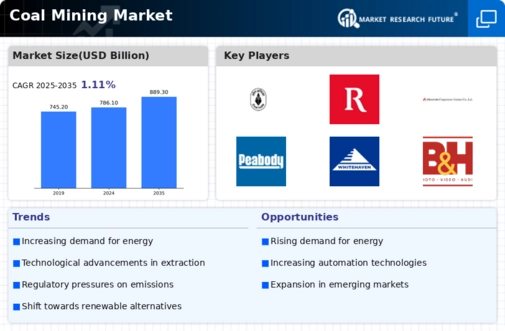Rising Energy Demand
The increasing The Coal Mining Industry. As economies expand, the need for reliable and affordable energy sources intensifies. Coal remains a significant contributor to energy generation, particularly in developing regions where access to alternative energy sources is limited. In 2023, coal accounted for approximately 27% of the world's energy supply, highlighting its continued relevance. This trend is expected to persist, with projections indicating that coal consumption may rise by 1.5% annually through 2030. Consequently, the Coal Mining Market is likely to experience sustained growth as it meets the escalating energy needs of various sectors, including manufacturing and transportation.
Infrastructure Development
Infrastructure development plays a crucial role in driving the Coal Mining Market. The expansion of transportation networks, such as railways and ports, facilitates the efficient movement of coal from mining sites to consumers. In many regions, significant investments in infrastructure are underway to support industrial growth and energy needs. For example, countries with burgeoning economies are prioritizing infrastructure projects that enhance coal supply chains. This trend is likely to stimulate demand for coal, as improved logistics reduce costs and increase accessibility. As infrastructure continues to develop, the Coal Mining Market is expected to benefit from enhanced operational efficiencies and expanded market reach.
Technological Advancements
Technological innovations are reshaping the Coal Mining Market, enhancing efficiency and safety in mining operations. The adoption of automation and advanced data analytics is streamlining processes, reducing operational costs, and minimizing environmental impacts. For instance, the integration of remote-controlled machinery and real-time monitoring systems has improved productivity and safety standards. Furthermore, innovations in carbon capture and storage technologies are addressing environmental concerns associated with coal usage. As these technologies evolve, they may bolster the competitiveness of coal as an energy source, potentially leading to increased investments in the Coal Mining Market. The ongoing research and development efforts suggest a promising future for coal mining operations.
International Trade Dynamics
International trade dynamics are a significant driver of the Coal Mining Market. The global coal trade is influenced by various factors, including demand fluctuations in importing countries and supply constraints in exporting nations. For instance, countries like China and India are major consumers of coal, driving demand for imports from coal-rich nations. In 2023, coal exports reached approximately 1.1 billion tons, underscoring the importance of international trade in the coal sector. Additionally, geopolitical tensions and trade agreements can impact coal prices and availability, further shaping the market landscape. As trade dynamics evolve, the Coal Mining Market must adapt to changing global conditions to remain competitive.
Government Policies and Support
Government policies and support mechanisms significantly influence the Coal Mining Market. Many governments recognize the importance of coal in ensuring energy security and economic stability. As such, they may implement favorable policies, including subsidies and tax incentives, to promote coal production and consumption. In certain regions, coal remains a vital component of energy strategies, particularly where renewable alternatives are not yet viable. This support can lead to increased investments in coal mining operations, thereby bolstering the market. However, it is essential to note that policies may vary widely, with some regions pushing for a transition to cleaner energy sources, which could impact the long-term outlook for the Coal Mining Market.

















Leave a Comment